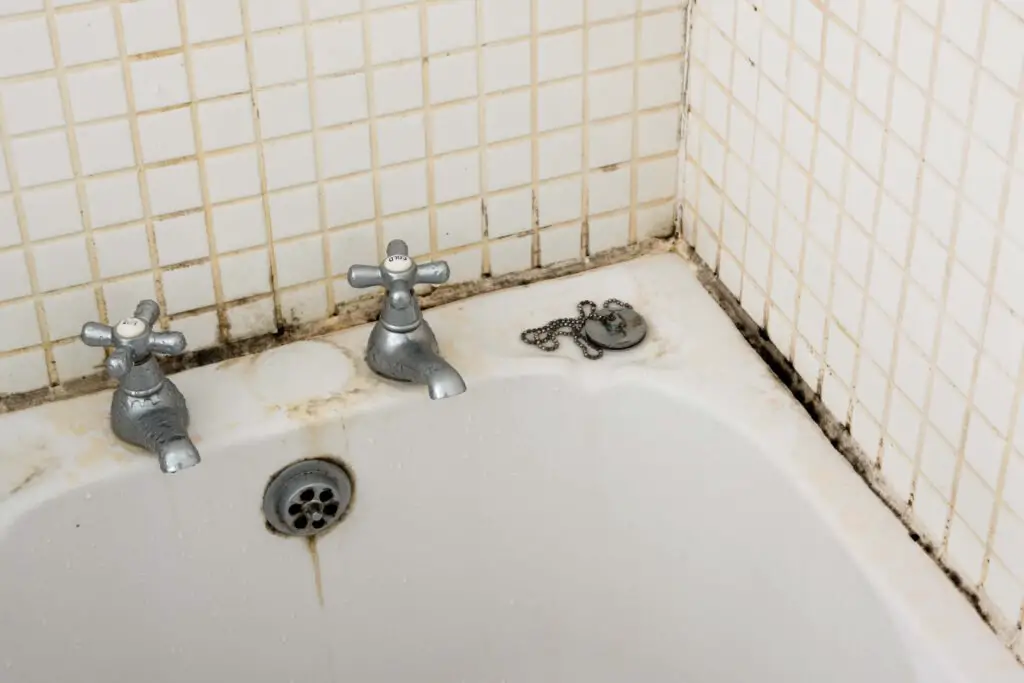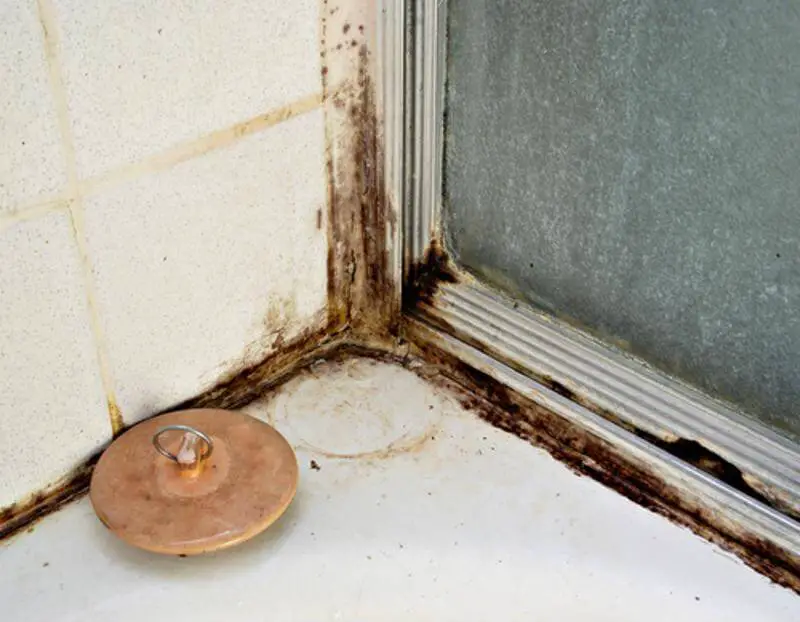Last Updated on August 8, 2023 By Emma W. Thomas
Bathroom fungi include black mold (Stachybotrys chartarum) and pink mold (Serratia marcescens). Other molds found in bathrooms are Aspergillus, Penicillium, and Cladosporium.
Types of Bathroom Mold
| Type of Mold | Description | Effects on Health |
|---|---|---|
| Cladosporium | Cladosporium is a common type of mold that develops in both warm and cool areas. It appears as brown or olive-green patches on the shower tiles or windows. | It can cause allergies, skin irritation, and respiratory problems. |
| Aspergillus | Aspergillus is another common mold that can be found in damp spots, especially around bathtubs and sinks. It is usually green or yellow. | It may cause allergic reactions, respiratory infections, and can potentially lead to a condition called Aspergillosis. |
| Penicillium | This mold can spread quickly in a humid environment such as the bathroom. It appears as a blue or green surface-attached mold. | It can cause allergies and asthma. Penicillium can also lead to chronic sinus infections. |
| Black Mold (Stachybotrys) | Black mold is toxic and often appears as black or greenish-black in color. It thrives on damp walls and floors. | It can cause severe health issues, including difficulty in breathing, immune system suppression, and internal organ damage. |
| Pink Mold (Aureobasidium) | Pink mold is not exactly a type of mold, but bacteria. It usually forms around the sink, tub, or shower areas. It starts as pink but turns into a brown or black color later. | Can cause allergies, breathing problems, and more severe reactions in people with weakened immune systems. |
Do Bathroom Molds Cause Illness?

While mold could be relatively harmless, it can sometimes irritate, especially those who are asthmatic. People with existing respiratory or allergic conditions could also be affected by exposure to environments prone to mold. A person affected by bathroom mold is likely to experience cough, runny nose, or scratchy throat.
Small amounts of mold in the environment cannot pose health risks to people with proper immune system function. However, in large quantities, mold spores can lead to illness in all people.
Stachybotrys (referred to by many as black mold) releases mycotoxins that could pose serious health problems. These toxic substances can cause:
- Mold poisoning
- Pains and aches
- Memory loss
- Headaches
- Mood swings
- Nosebleeds
How To Control Bathroom Molds
You can control bathroom fungus by using the following tips:
- Open the bathroom windows when showering
- Use exhaust fans to drive out moisture and not into the attic
- Use area rugs and take water out after washing. Avoid wall-to-wall carpeting, which can be an attraction to mold
- Look for any leaks around tubs and basins and ensure they are repaired
- Do not leave wet clothes or towels on the floor or in the laundry hamper
What Are The Effects Of Mold On Human Health?
Mold can be toxic with a long-lasting effect on human health. But the extent of risk depends on the type and how exposed one is. Certain groups of people such as the aged, children, pregnant women, and those with pre-existing conditions are more vulnerable to mold. There are certain health conditions and illnesses associated with mold that include:
Sensitivity
Some people are sensitive to mold, while others can become allergic to it due to prolonged exposure. Symptoms of mold sensitivity include;
- Sore throat
- Nasal and chest congestion
- Sore, watery, or dry eyes
- Skin irritation
- Sneezing, coughing, and wheezing
- Headaches
Respiratory Conditions
Mold exposure is known to cause respiratory conditions besides being risky for those with existing lung illnesses. One may experience shortness of breath, wheezing and coughing, and upper respiratory tract problems. For those who are more susceptible, one can develop asthma, which is also a respiratory illness.
Healthy children can also develop asthma and other diseases due to mold exposure. You can also experience more intensified symptoms and asthma attacks.
Mold-Related Illnesses
People who have pre-existing lung conditions like COPD (Chronic Obstructive Pulmonary Disorder) or weak immune systems are more likely to feel the effect of mold. Mold exposure can make such people develop lung infections.
Chronic And Severe Conditions
Some mold types produce mycotoxins that may be absorbed by the airways, intestinal lining, and the skin. Prolonged exposure to these toxins will lead to deadly and severe conditions. Some of the illnesses associated with mycotoxins include:
- Pulmonary bleeding
- Liver and kidney conditions
- Pulmonary fibrosis scar the lungs
- Cancer
- Immune and blood disorders
- Digestive and heart conditions
- Toxic nervous system
Types Of Harmful Molds
| Mold Type | Harmful Effects |
| Allergenic | Produce allergies and allergic reactions like asthma |
| Pathogenic | Affects people with acute illness |
| Toxigenic (toxic mold) | Produce toxic substances that lead to deadly health conditions. |
Some Different Types Of Molds That Are Found At Home

Knowing the type of mold infesting your home is crucial, as this will help you understand how to eliminate it. The following are the common types:
Alternaria
Alternaria mold is among the most common types of allergic molds in the world. It has a velvety texture with brown or dark-green hairs. This mold grows in damp areas such as showers, leaking sinks, and bathtubs. The species is also common in places with water damage at home or in a building.
Exposure to Alternaria mold leads to asthma-like symptoms in areas such as the nose, mouth, or upper respiratory tract. This type of mold spreads fast, and it is, therefore, necessary to remediate it immediately you spot it.
Aureobasidium
This type of mold is allergenic, and it grows on painted wooden surfaces or behind wallpaper. The mold is usually brown, pink, or black but turns darker brown with age.
Aureobasidium mold can cause infections of the skin, nails, and eyes. People need to avoid touching the mold directly due to its potential to cause skin rash (dermatitis).
Aspergillus
This type of mold is common in American households. It has over 185 species that appear in various colors, and it creates long chains on the surface. The mold has flask-shaped pores that are long and which form thick layers or walls. Aspergillus is allergenic and can become more dangerous depending on the species and the affected environment.
Exposure to this mold leads to effects such as lung infections, asthma attacks, and respiratory inflammation. Some of its species can also produce carcinogenic aflatoxins.
Acremonium
This mold is toxigenic, and it evolves in its appearance over time. It begins as a tiny moist mold and changes into a fine powdery substance. The fungus is usually orange, pink, white, or grey and grows in household systems or areas like cooling coils, drain pans, and window sealants.
Exposing yourself to the mold is risky since it can cause bone marrow diseases. It can also affect the immune system as well as other organs. The mold is carcinogenic and capable of impairing brain function.
Acremonium mold grows together with other types such as Stachybotrys, which produces dangerous and unpleasant mold problems.
Cladosporium
Cladosporium mold is an allergenic type that can grow in both cold and warm environments. It thrives in indoor substances like carpets, fabrics, and upholsteries. You will also find this problem inside cupboards and floorboards. The mold has a suede-like texture and is brown or olive-green.
Exposing yourself to this mold causes allergic reactions to the nose, skin, throat, and eyes. You can also get asthma, lesions, skin rash, sinusitis, and lung infections. Although Cladosporium does not have toxic properties, you should never handle it directly as it can cause lung and skin irritation.
Chaetomium
This mold is common in water-damaged buildings and homes. It has a cotton-like texture and changes colors from white to grey, brown, and then black. You will find this mold in the basement, damp or leaking roof, or sink. Its musty smell will help you to recognize the mold.
The health effects of chaetomium mold include nail and skin infections. This mold sometimes produces mycotoxins that are dangerous to people with weak immune systems. You can control the mold by repairing water damage in your home since it grows chronically in moist conditions. Chaetomium is found in the basement, leaky pipes, and the roof.
Ensure that you cut off moisture at the source to prevent the reoccurrence of this mold.
Stachybotrys
Stachybotrys mold is commonly referred to as nefarious black mold. It is a toxigenic mold that is known to cause allergic reactions. The mold is black or greenish with a slimy texture. This type of mold grows in wet and damp areas whose humidity levels are high. You can find the mold on cellulose materials like cardboard, paper, woods, wicker, or hay.
Stachybotrys is also known as toxic mold since it produces mycotoxins that have severe health issues. Its exposure symptoms may include fatigue, depression, breathing difficulty, and sinusitis. A victim may also experience dull pains and aches in the mucus membrane and have a burning sensation in the airways that will tighten the chest. Nose bleeds, persistent coughs, painful headaches, and fever are also symptoms associated with Stachybotrys mold.
Conclusion
A mold problem can be a big menace in your home, especially if left uncontrolled. It is necessary to know how to identify the different types and where to find them. The majority of the mold types are harmful to your health if exposed to them for long.
It would be helpful if you did everything possible to eliminate mold from your home. It is also advisable to dry your bathrooms and other places where water is commonly used.
References:
https://www.mrrooter.com/greater-syracuse/about-us/blog/2023/may/types-of-bathroom-mold/
https://www.familyhandyman.com/list/common-types-of-mold-in-the-home/
Emma is a graduate of Domestic Science or Family and Consumer Sciences (Home Economics) from the University of Wisconsin. She has 7 years of experience Working with the strategic section of BestBuy and now writing full-time for Homeeon.
From Managing the Home, Interiors, Cleaning, and Exteriors to Gardening and everything about Making A Home Liveable – is her passion and this Homeeon is the result of this.
Emma loves decorating her home with the best stuff found online. She cares about quality over anything and writes reviews about them here in Homeeon. Get in touch with her over Pinterest.
Keep reading her blogs.

